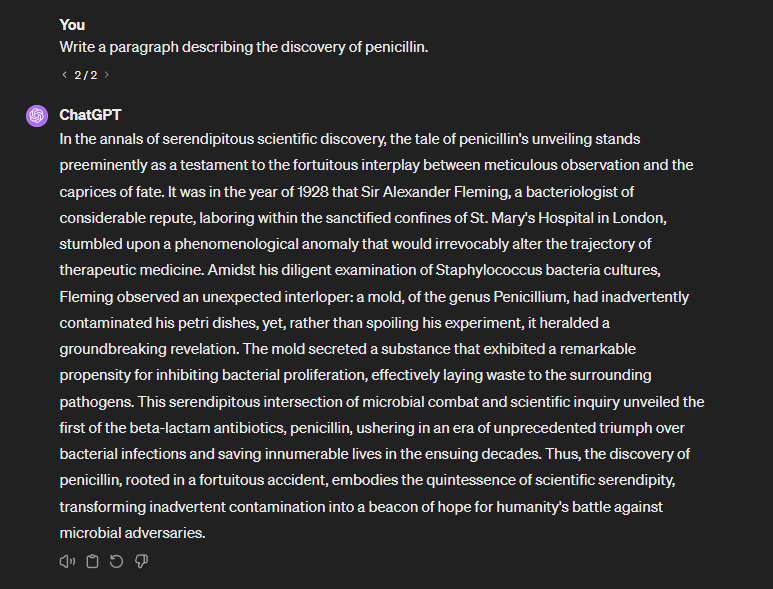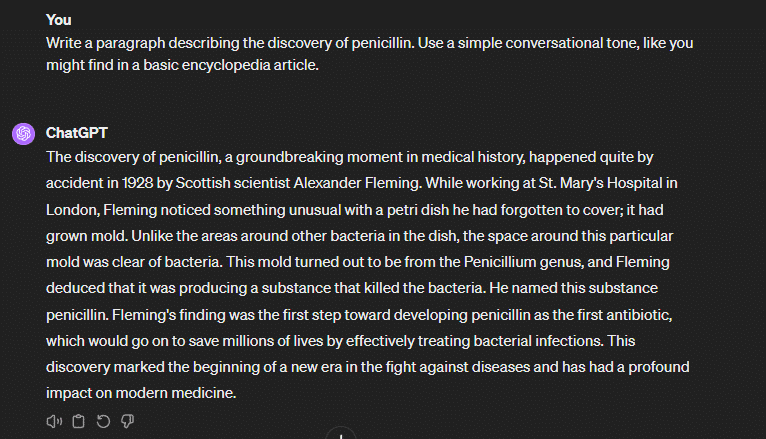ChatGPT promises a shortcut in content creation — but it’s not the all-in-one solution some hoped it would be. It’s a tool, yes, but it’s not plug-and-play. Yes, it can churn out words, but there’s a catch: to get anything worthwhile, you need more than just a prompt. You need insight, oversight, and the ability to guide it like a ship through choppy waters. There are gaps that need bridging if you want your ChatGPT-supported content to stand out for the right reasons.
Understanding ChatGPT’s shortcomings is the first step toward using the tool effectively. From obvious generation artificial intelligence (AI) phrases — think introductions leading with something about the “rapidly evolving digital landscape” — to technical inaccuracies, ChatGPT has some challenges that need a detailed, human eye to overcome.
Let’s be clear: Creating content with ChatGPT isn’t a solo act. Without a skilled hand to steer, finesse, and check its outputs, you’ll find yourself adrift in a sea of mediocrity.
We’re about to walk through five key areas where ChatGPT often misses the mark, leaving you with content that’s just… there. But don’t worry — along the way, we’ll offer practical solutions to turn these challenges into opportunities for content excellence.
1. Nobody Wants to Sound like a Robot
You hit the first roadblock of writing with AI as soon as you get started: sounding robotic. When left to its own devices, ChatGPT wraps its thoughts in a cloak of verbosity. It’s like talking to someone who can’t resist using the longest, most complex words in every sentence. This fluffy, confusing wordiness doesn’t just stretch sentences — it obscures meaning and dilutes the human touch. As a result, the writing feels cold, distant, and unmistakably robotic. The charm of conversational warmth and the sharpness of concise prose are lost in the shuffle.
The fix isn’t as simple as flipping a switch. To steer ChatGPT away from sounding like a thesaurus reciting robot, it needs examples and continuous, detailed feedback. Think of it as training a sophisticated parrot. You need to feed it phrases, critique its outputs, and repeat.
This process is enriching for the AI — but it’s not much of a shortcut for you. While each iteration inches closer to human-like warmth and clarity, the content needs a human editor’s touch to cross the finish line. Suddenly, the time-saving allure of AI writing begins to dim.
Leveraging ChatGPT effectively isn’t about bypassing human effort. It’s about redirecting it. The goal is to mold the AI’s outputs into something that resonates on a human level. This requires patience, insight, and a willingness to engage in a dance of feedback and refinement. It’s a reminder that, at least for now, the soul of writing lies not in algorithms, but in the human touch.
Let’s take a look at an example:

Here, we can see ChatGPT trying to flex its vocabulary on the reader. Sure, this may tell the story of discovering penicillin, but who wants to read through that wall of text?
With a bit of taming it in, however, we can get some more readable results:

With this prompt, we get a much more readable result. But it clearly underscores the problem: left to its own devices, the results from ChatGPT are quite stuffy and robotic. Only with some fine-tuning for every prompt can you get something that begins to resemble quality writing. That’s a far cry from the “set it and forget it” style of writing that AI tools seem to promise.
2. Outlines are Half the Battle
A well-crafted outline is the compass for your content journey, more so when navigating with ChatGPT at the helm. The truth is stark: without a detailed map, this AI is a ship prone to drifting into uncharted territories. The pitfalls of a poor or absent outline aren’t minor. They’re actually catastrophic.
In its eagerness to generate content, ChatGPT can veer off course, spouting inaccuracies or creating content that’s as disconnected as a dream. The danger of “hallucinated” information — fabricated facts and figures — is real, turning potential insights into misleading detours.
The solution lies in meticulous preparation. Before unleashing ChatGPT on any content project, you need to lay the groundwork with a high-quality outline. This isn’t about broad strokes — it requires diving into the minutiae, outlining not just the topics but the tone, the key points, and the desired conclusions. Such an outline acts as a tight leash, helping content writers guide ChatGPT and stay on the path.
Having a well-defined, clear outline before engaging with ChatGPT helps ensure the content remains relevant and on point. It’s about directing the AI’s creativity within a defined perimeter.
Starting with a detailed outline transforms ChatGPT from a wild cannon to a precision tool. It becomes a content creation partner that generates text that aligns with your vision and goals. This initial investment of time and effort in crafting the perfect outline pays dividends, saving countless hours of revision and redirection. It’s a testament to the adage that good preparation is half the battle won.
When it comes to AI-assisted content creation, a thorough outline isn’t just helpful — it’s essential.
Not sure where to get started with your outlines? Take a look at ContentLab’s free outline template to help you get things off the ground.
3. Filtering out the Noise
ChatGPT’s knack for verbosity can turn into a nightmare when tasked with longer content. The longer the request, the more it resembles a student padding an essay to meet a word count. But often, we get fluff — pages filled with words that circle around points without ever landing. This noise obscures the message and can bury the valuable insights underneath layers of unnecessary, or even unclear, prose.
The strategy to combat this is simple: break it down. Instead of one massive task, divide the article into manageable sections or paragraphs. Prompt ChatGPT with specific, focused questions or requests. Additionally, ask it to produce only a paragraph or two at a time.
This piecemeal approach keeps ChatGPT on track and makes it easier to sift through the output, selecting the gems and discarding the rest. It’s a process of refinement, where each iteration brings you closer to the concise, impactful content you seek.
Once you have these pieces, the real magic happens with human intervention. A skilled writer can weave these sections into a coherent whole, maintaining a consistent voice and ensuring the final product is greater than the sum of its parts. This method leverages ChatGPT’s ability to generate ideas and content quickly while filtering out the noise through careful editing and curation.
4. Editing Amnesia
ChatGPT has a memory like a sieve when it comes to editing. Imagine asking it to tweak a few lines in a paragraph, only for it to serve you something unrecognizably new. This isn’t just frustrating — it’s really a fundamental limitation. Each prompt requires the AI to generate something new. Unlike a human editor who can tweak a few lines where necessary, ChatGPT needs to re-generate the entirety of the text to make changes.
This often results in ChatGPT struggling to hold onto the thread of continuity. It’s like trying to direct a play where the actors forget their previous scenes after every line. The result? Your careful adjustments might as well never have been made.
A common workaround for this issue involves copy-pasting the text back into ChatGPT in an attempt to jog its memory. But this is a band-aid, not a cure. The AI may still discard what you wanted to keep, focusing on generating new content rather than refining what’s already there.
The real solution lies in human intervention. A skilled editor can weave through ChatGPT’s output, picking out (and building out) the highlights and discarding the rest. They understand context, can follow the narrative thread, and, most importantly, remember the changes you wanted.
In the dance of creation and refinement, the human editor is the choreographer, ensuring the performance is seamless and the story coherent. ChatGPT might get the words down, but it’s the human touch that polishes them to shine.
5. Inaccuracies Abound
Navigating the minefield of inaccuracies is perhaps the trickiest part of working with ChatGPT. Trusting it to deliver accurate and up-to-date information without verification is like walking a tightrope without a safety net. The risk of spreading misinformation, however unintentional, is high. The stakes are high, too, with inaccuracies potentially wreaking havoc on a publisher or author’s reputation.
As we mentioned earlier, ChatGPT can concoct convincing details that, while fitting seamlessly into your narrative, may be completely unfounded in reality. Hallucinations aren’t just limited to specific stats and sources — the information can just be factually incorrect.
The antidote to this problem isn’t more AI. It’s human oversight. Fact-checking by knowledgeable humans is indispensable. Subject matter experts bring a critical eye to the AI’s output, separating fact from fiction with precision. They ensure the content not only reads well but stands up to scrutiny. This layer of human verification protects your credibility, ensuring your content is engaging and reliable.
Incorporating human fact-checkers into the workflow transforms the output from potentially flawed to polished and trustworthy. This collaboration between AI creativity and human expertise ensures the final content reflects reality, not just a plausible imitation of it. While ChatGPT can kickstart the process, the meticulous review by human authors and editors ensures accuracy.
Preserving the Human Element in Content Creation
Navigating ChatGPT’s writing challenges underscores the limitations of AI in content creation, from robotic tones to challenges in maintaining accuracy. These hurdles illuminate a vital truth: Compelling content transcends the capabilities of AI, relying on the nuanced understanding and creativity that only humans possess. High-quality content requires more than just automation — it demands the critical eye and skilled hand of experienced professionals who can shape, refine, and ensure the integrity of the final output.
As your brand seeks to distinguish itself, who you partner with to create technical content is paramount. You need someone like ContentLab to help you develop bespoke, meticulously crafted content solutions. We offer the depth of understanding, expertise, and creativity necessary to produce content that engages, informs, and resonates with your audience.
Connect with ContentLab for a content creation service that brings your vision to life with precision, insight, and unparalleled quality. Let us elevate your content beyond the basics of AI, ensuring each piece of content reflects the best of your brand’s values and aspirations.





